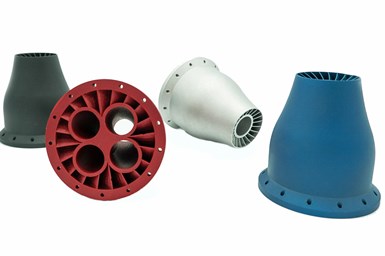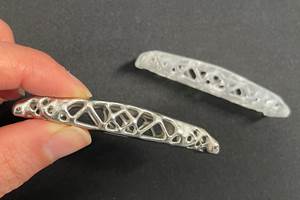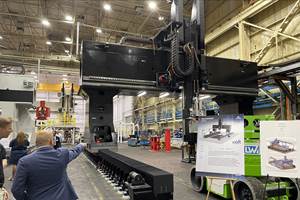EOS Aluminum Al5X1 Is High-Strength Anodizable Alloy for Industrial 3D Printing
The aluminum alloy offers light weight, high strength, elongation and corrosion resistance.
EOS’ Aluminum Al5X1 is an aluminum alloy engineered specifically for additive manufacturing (AM), but at a more competitive cost than other aluminum alloys with similar strength and elongation properties. The EOS Aluminum Al5X1 delivers excellent performance and material properties with a combination of high strength and elongation, around 410 MPa UTS and 14% elongation.
Requiring only a single-step heat treatment with no Hot Isostatic Pressing (HIP), organizations can manufacture parts faster and at a lower total cost. The 3D printed applications using EOS Aluminum Al5X1 can also be electropolished and anodized (Type II and Type III) for both cosmetic (colored) and corrosion-resistant protective properties. There are no limits to potential color choices, which could be important to consumer-facing products.
EOS Aluminum Al5X1 was tested by multiple organizations, including leading semiconductor, aerospace and defense companies. Early adopters have noted the material’s exceptional performance combined with the competitive cost-per-part (CPP) has created a strong business case for production implementation.
“Since early 2023, we have been working to develop Al5X1 performance data and material allowables on behalf of our prime customers,” says Brian Neff, Sintavia founder and CEO, a designer and additive manufacturer of mechanical systems for the aerospace and defense industry. “Preliminary results are very promising, and we look forward to introducing Al5X1 across our thermodynamic product lines. Developing a higher performing aluminum alloy is of critical importance not only to us, but also to the industry as a whole.”
A combination of high strength and high elongation for an aluminum alloy is critical for manufacturers in industries like aerospace. “But equally crucial is delivering the property combination at a reasonable cost,” says Dr. Ankit Saharan, EOS senior manager of metals technology. “Also interesting is that since the material can be anodized, this makes it very attractive to OEMs in areas like consumer electronics who are seeking to produce different colored products to suit customers’ preferences, with the added bonus of corrosion resistance.”
- Read about EOS developing sustainable polymers for additive manufacturing. The climate-neutral PA 1101 and carbon-reduced PA 2200 polymer materials are designed to increase production efficiency, while supporting more sustainable additive manufacturing.
- Learn about the EOS collaboration with nTop to create file capability that would limit design data bottlenecks. EOS and nTop have created a new nTop Implicit File that can result in up to 99% smaller file sizes, 500 times faster file generation and 60% faster load time, making it more readily available to additive manufacturing build preparation software for manufacturing.
Related Content
AM 101: NanoParticle Jetting (NPJ)
The proprietary process from XJet builds ceramic and metal parts using nanoparticle suspensions. Learn how NPJ works in this introductory article, part of our AM 101 series.
Read MoreAluminum Gets Its Own Additive Manufacturing Process
Alloy Enterprises’ selective diffusion bonding process is specifically designed for high throughput production of aluminum parts, enabling additive manufacturing to compete with casting.
Read MorePossibilities From Electroplating 3D Printed Plastic Parts
Adding layers of nickel or copper to 3D printed polymer can impart desired properties such as electrical conductivity, EMI shielding, abrasion resistance and improved strength — approaching and even exceeding 3D printed metal, according to RePliForm.
Read MoreWorld’s Largest Metal 3D Printer Seen at Ingersoll Grand Opening Event
Maker of large additive and subtractive machines adds capacity in Rockford, Illinois.
Read MoreRead Next
3D Printing Brings Sustainability, Accessibility to Glass Manufacturing
Australian startup Maple Glass Printing has developed a process for extruding glass into artwork, lab implements and architectural elements. Along the way, the company has also found more efficient ways of recycling this material.
Read MoreLooking to Secure the Supply Chain for Castings? Don't Overlook 3D Printed Sand Cores and Molds
Concerns about casting lead times and costs have many OEMs looking to 3D print parts directly in metal. But don’t overlook the advantages of 3D printed sand cores and molds applied for conventional metal casting, says Humtown leader.
Read MoreGE Additive Rebrands as Colibrium Additive
As part of the brand name transition, both the Concept Laser and Arcam EBM legacy brands will be retired.
Read More












.png;maxWidth=300;quality=90)











